Biology
Sponges and birds ? they?re both animals, but would you know it to look at them? Sponges are sessile (except for the exceptions), and birds can?t breathe under water (no exceptions). Birds eat worms and lay eggs ? most people don?t know what the heck sponges do. Yet they?re both animals. Are there characteristics that all animals have in common?
The roundworms, phylum Nematoda, are our exception for the day. Their male gametes can?t swim! But who cares, it hasn?t seemed to slow them down. Which makes us ask why everyone else goes to the trouble of producing gametes with flagella ? it?s expensive. Shall we investigate?
Actin comes on a two main forms. G-actin is the globular form; it's the monomer. When the monomers are induced to form filaments, like tubulin monomers monomers form microtubules, it's now called F-actin. Quick assembly and disassembly of F-actin polymers from G-actin monomers allows for movement of selected parts of the cell membrane.
In strictly numerical terms, it?s amazing that we aren?t nematodes. In truth, four out of every five animals are Earth are roundworms! Long ago in classification, all the roundworms used to be lumped together; later on they were grouped according to head size. With the advent of molecular typing, there are more than 25,000 species, and estimates are for more than a million. Compare that to 5000 known mammal species.
A. lumbricoides is the largest nematode by mass which infects humans. Females can be 40 cm long and the diameter of a No. 2 pencil. The worm takes quite the tour through you. From your stomach to your liver to your lung move the young larva. You cough them up and swallow them, and they mature in the gut. There they grow, fall in love, and mate. Yep?pretty gross.
The German beer mat nematode, Panagrellus redivivus, was first named Chaos redivivum by none other than Linnaeus himself. Its story is told in a nice 2009 commentary. While nematologist Cobb was aware of this worm only from felt beer mats, in truth they live in rotting peaches, in book binding paste and in other places as well.
Smith HE (2014). Nematode sperm motility. WormBook : the online review of C. elegans biology, 1-15 PMID: 24715710
H. Ferris (2009). The beer mat nematode, Panagrellus The beer mat nematode, Panagrellus redivivus: A study of the connectedness of scientific discovery J. Nematode Morphol. Syst., 12 (1), 19-25
McKnight, K., Hoang, H., Prasain, J., Brown, N., Vibbert, J., Hollister, K., Moore, R., Ragains, J., Reese, J., & Miller, M. (2014). Neurosensory Perception of Environmental Cues Modulates Sperm Motility Critical for Fertilization Science, 344 (6185), 754-757 DOI: 10.1126/science.1250598
Morgan, E., Azam, D., & Pegler, K. (2013). Quantifying sources of environmental contamination with Toxocara spp. eggs Veterinary Parasitology, 193 (4), 390-397 DOI: 10.1016/j.vetpar.2012.12.034
Sepsenwol S, Ris H, & Roberts TM (1989). A unique cytoskeleton associated with crawling in the amoeboid sperm of the nematode, Ascaris suum. The Journal of cell biology, 108 (1), 55-66 PMID: 2910878
- Animal Eukaryotic Cell Components: Structure And Function
I posted a picture of the eukaryotic animal cell earlier, but it was simply a labeled diagram. Here we will go into each of the major parts of the cell, as well as each organelle's function, not to mention the overall structure of the cell. As the...
- 1. Reproduction In Organisms
Click here for PDF- Reproduction is a process in which an organism gives rise to young ones (offspring) similar to itself. - The period from birth to the natural death of an organism represents its life span. - ...
- An Immovable Moving Part- That?s Just Cilia!
Biological concepts ? primary cilia, sterocilia, kinocilium, Usher syndrome, actin, microtubule, signal transduction, sensory receptor, mechanoreceptor The USS Oriskany (above) was scuttled in 2006 to create an artificial reef off of Pensacola...
- Everybody In The Gene Pool - Plants That Swim
Biology concepts ? botany, taxonomy, alternation of generations, cycad, gametophyte, sporophyte, gametes, motility, ginkgo, archegonium, antheridium In the LOTR The Two Towers we find the tree herders that can move on their own despite being plants....
- Almost This Or Almost That? Must Be The Other
Biology concepts ? Protista, taxonomy, phylum, kingdom, monophyletic, paraphyletic, cladistics, algae, diatom, dinoflagellate Euglena gracilis is an organism in the Kingdom Protista. It has one long flagellar undulipodium, but it can also move by...
Biology
Crawling To The Top
Biology concepts ? characteristics of animals, undulipodia, gametes, nematodes, roundworms,
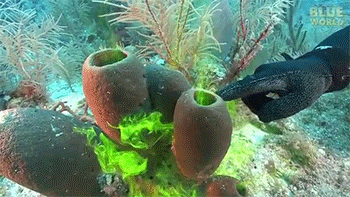 |
| Yes, a sponge is an animal ? just like a barracuda, a platypus or a that weird nephew of yours. They are multicellular, loosely organized into a couple tissues, and eat other organisms. You can see how they filter feed in this demonstration. Not so different from that nephew. |
Yes there are, thanks for asking. Animals are all eukaryotic and diploid (2 of each chromosome). For the most part, our cells have nuclei and organelles and all but our gametes have two copies of each chromosome.
Animals are all multicellular - a unicellular organism that acts like an animal is still called a protist. Because they are multicellular, animals have the capability to have cells of different types that organize themselves into tissues and organs, like we have discussed before as a characteristic of life.
Another attribute of animals is that they can move. True, sponges are sessile when attached to rocks or coral reefs, but they do have motile cells and motile life cycle stages. Birds are very motile unless dead.
One other thing animals have in common is how the male gamete finds the female egg. Male gametes have a flagellum that allows them to swim toward the chemical signals that show them where the egg is located. True, we have learned that protists and some lower plants also have gametes that swim with flagella or cilia, but animals characteristically have flagellated male gametes. But of course, given the nature of this blog, there must be an exception.
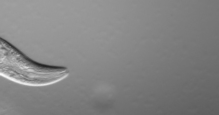 |
| Nematodes are round worms; helminthes are just one group of parasitic roundworms. They represent a turning point in animal development. They sort of have an internal body cavity (they are pseudocoelomates), they sort of have a head (start of cephalization) and they sort of have body symmetry (starting to be bilateral). |
In every other phylum of animals, male gametes use the eukaryotic flagellum to swim their way to the egg. Using exactly the same structure that we have talked about before, male gamete flagella have basal bodies and axonemes made of microtubules. The microtubule filaments slide past one another to produce their beating movement.
Look as hard as you want, but round worms don?t have basal bodies or flagella. They do have centrioles and centrosomes used for mitosis, but none of them mature into basal bodies for flagellar assembly, In fact, the male gametes of nematodes carry one centrosome (with its centriole pair) to the egg and form the basis of all centrioles in the baby roundworm. Weird - why no basal bodies? ? I have no idea, but evolution approved it.
Instead of flagella for male gamete swimming, nematodes use an amoeboid movement to crawl to the egg. O.K., so they crawl instead of swim. That?s exceptional, but is it really that weird? Well? yes, considering that they don?t contain the most important protein that most cells use to make amoeboid movements.
Actin is one of the major proteins of the cytoskeleton. Actin works mostly in protrusion and contraction of parts of the cell, while intermediate filaments hold the cell?s shape and give it rigidity and microtubulesare primarily for movement of proteins and structures throughout the cell.
| This short video shows you the movement of C. elegans male gametes. They are shaped like typical animal male gametes, they don?t move like typical male gametes, and they don?t have the same proteins as typical ones. Yet, the nematode is the most numerous type of animal on Earth. |
So amoeboid cells use F-actin as the way they extends and retracts its pseudopodia. Thus, they crawls along. Nematodes do have cells with G- and F-actin, but the male gametes don?t have any (or very little). But it?s the male gametes that need it to move! What gives?
Instead, male gametes of nematodes use the MSP protein (major sperx protein; my posts get blocked by schools if I use the whole word, so I use gamete whenever possible). A 2014 study shows that MSP proteins are abundant in the male gamete (40% of total soluble protein), and change its distribution and volume as the gamete matures and is activated. When fully activated and in the female oviduct, the MSP of the male gamete assembles and creates pseudopodia just as actin would in any other amoeboid cell. Another 2014 study shows how it then senses the egg.
Does the inability of nematode male gametes to swim to the egg cost them in terms of reproductive advantage and evolution? Heck no.
Nematodes, ie. roundworms, are the most successful animals on Earth. They live inside every other living thing, and just about everywhere on Earth. There are free living worms, parasitic worms, and worms that eat decaying tissue. There are roundworms that eat nothing but other roundworms.
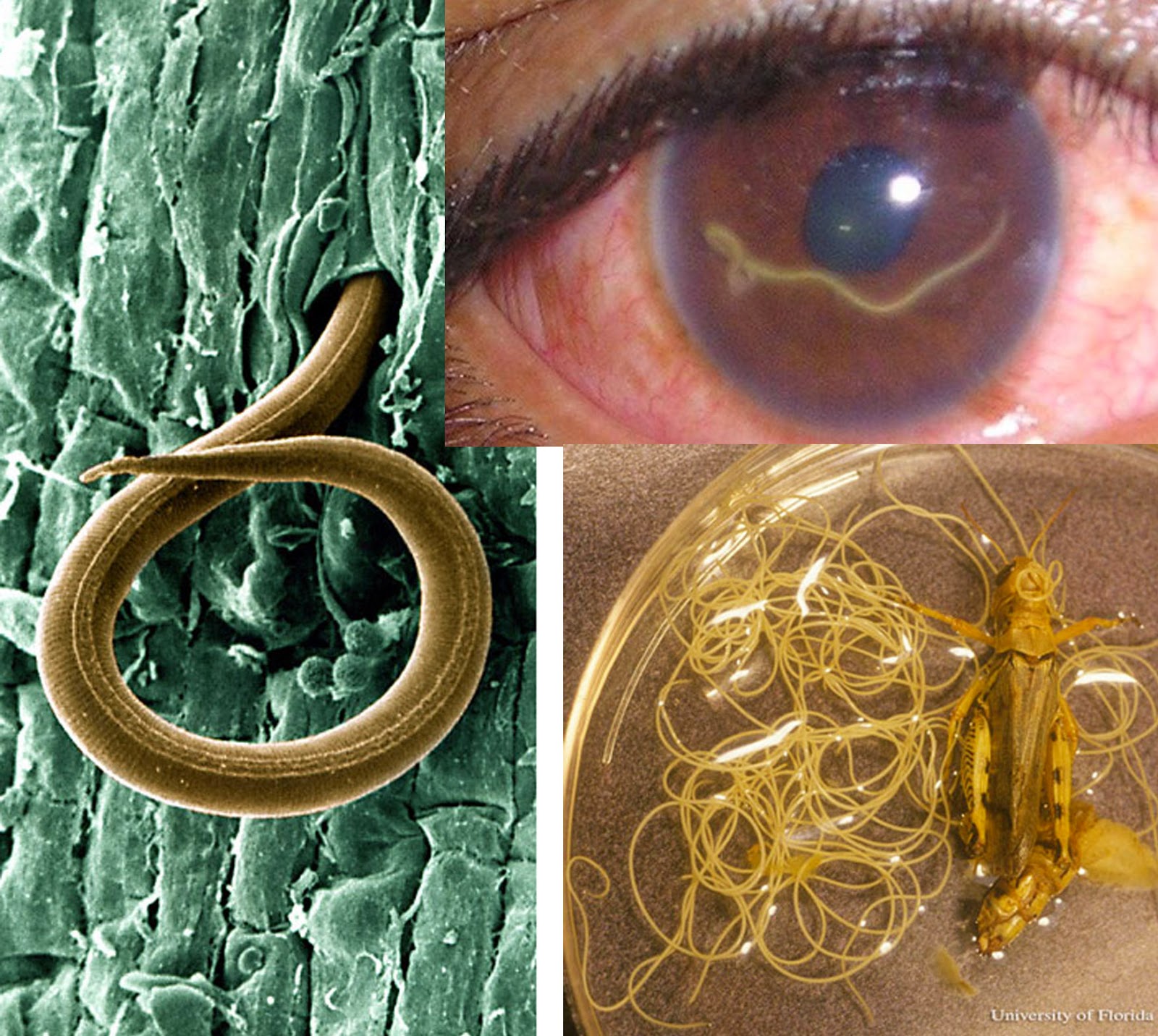 |
| Nematodes are famous for the parasitic infections they cause. On the left is a root knot worm. Nematodes are responsible for more than 15% of crop loss each year. On the top is one of the filarial worms that cause river blindness. On the bottom is a grasshopper worm (Mermis nigrescens) that grows to fill the entire body cavity. |
Sure there are many species, but that number is dwarfed by the number of individuals of some species. One 2013 study from England gives us a clue. In just the city of Bristol, dogs drop about four tons of doo-doo each day. That four tons holds an astounding 3.7 billion Toxicara eggs. Every two days the dogs of that one city squat out the equivalent of the human population of the entire world. Man, is that a bizarre visual.
This isn?t useless information, considering that the eggs become worms that can cause blindness in people who accidentally eat contaminated dirt, or those who eat dirt on purpose for that matter. Indeed, many nematodes are parasites of humans and cause much disease, but this isn't our focus today. If you like that sort of weird disease stuff (and I most certainly do), I suggest you Google ascariasis, hookworm, onchocerciasis, strongyloidiasis, filariasis, or trichinosis.
Nathan Cobb of the U.S. Bureau of Plant Industry gave a very apt description of the numbers and distribution of nematodes in 1915. He said that if you eliminated every bit of matter on Earth other than nematodes, an onlooker could still recognize our world.
There are enough nematodes in the dirt that we could distinguish mountains and valleys. There are more in the cities, so we would know where they had been. Nematodes are numerous enough in living things that we could identify where every living thing had once stood. And yes, the onlooker could see humans, we ingest billions over our lifetime and more than two billion people are infected with Ascaris lumbricoides at any one moment.
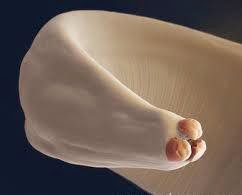 |
| At least 2 billion people are infected with this worm (Ascaris lumbricoides) at any one time. The pictures of the infection are just too gruesome, so I show his smile instead. Look can up the pictures for yourself if you haven?t eaten recently. |
The smallest nematodes are in marine sediment. Desmoscolex sp. and Greeffiella sp. are only 80 µm long, which means that if 30 of them stood on each other?s shoulders, they would only be as tall as a dime is thick.
At the other end of the spectrum, the largest known nematode is Placentonema gigantissima, which can reach around 30 feet long in the placenta of its host, the sperm whale.
The placenta of a whale, tree root balls, in water, mud, fruit, nematodes literally live everywhere except in the skies ? even though they do find themselves in the sky every day - inside birds. Roundworms have been found in the crevices of South African gold mines two miles below the Earth?s surface ? at 48? C (118.5? F) and 1000x atmospheric pressure. No other animal has been found living in stone at these depths and conditions.
Many roundworms live in the soil, and perhaps the greatest number live in the sediment of ocean floors. Because there are some many different kinds of nematodes, it isn?t surprising that many have very developed specific niches.
Biologist Colin Tudge stated in his book, The Variety of Life that half the animal species on Earth have a nematode that lives onlyin that species. Even beyond animal hosts, there is evidence of a nematode species that lives one place on Earth ? in the felt of German beer coasters.
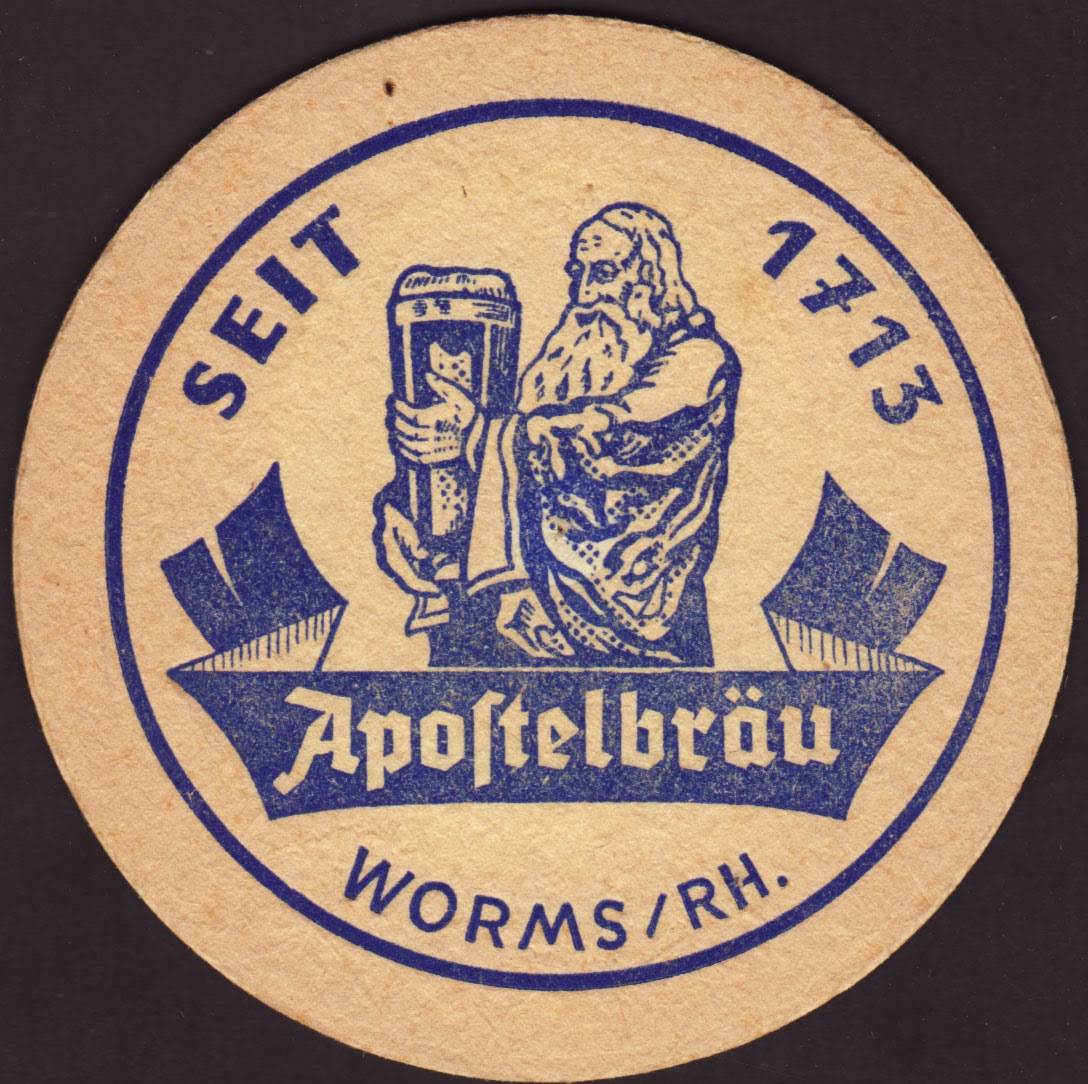 |
| The German beer mat worm doesn?t justlive on the bottoms of beer soaked coasters. But they do like yeast for dinner. I like this one for Apostelbrau in Germany because the brewery has been located in Worms, a city between Frankfort and Stuttgart, since 1713. |
Nematodes can be political was well. The giant kidney worm, Dioctophyma renale, is found in many different mammal species, such as dogs, cats, minks, humans, etc. But the infection is almost always just in the right kidney. Since this worm is usually ingested via contaminated fish, the right kidney might be more susceptible simply because it's closer to the liver and stomach ? or maybe they?re Democrats.
All this talk about undulipodia and nematodes has been perhaps a little misleading. Nematodes do have cilia on a very small subset of the their neurons, but they aren?t motile cilia. These are sensory cilia, also called primary cilia. They are our topic for next week.
For more information or classroom activities, see:
Nematodes ?
https://www.youtube.com/watch?v=fmOJ0bh8le4
http://oak.ppws.vt.edu/~sforza/nematode.html
http://sznitmanlab.bm.technion.ac.il/gallery/elegans
http://cal.vet.upenn.edu/projects/merial/Nematodes/nems_5.htm
http://www.accessexcellence.org/AE/ATG/data/released/0653-SamanthaOrchard/
http://www.apsnet.org/edcenter/k-12/teachersguide/nematode/Pages/default.aspx
http://www.sciencebuddies.org/science-fair-projects/project_ideas/Zoo_p045.shtml
http://ag.arizona.edu/ento/courses/ento524/
https://www.questia.com/library/journal/1G1-180555901/malthus-under-a-microscope-using-the-soil-nematode
http://www.apsnet.org/edcenter/intropp/lessons/Nematodes/Pages/RootknotNematode.aspx
http://www.apsnet.org/edcenter/intropp/lessons/nematodes/pages/soycystnema.aspx
http://sciencenetlinks.com/science-news/science-updates/nematodes/
http://www.muhlenberg.edu/main/academics/biology/nsf/ret/ret_nematode_lesson.html
http://urbanext.illinois.edu/soil/SoilBiology/nematodes.htm
https://www.youtube.com/watch?v=6okurk9O1ow
http://www.ucmp.berkeley.edu/phyla/ecdysozoa/nematoda.html
http://www.nematodes.com/
http://www.google.com/url?sa=t&rct=j&q=&esrc=s&source=web&cd=14&ved=0CDYQFjADOAo&url=http%3A%2F%2Fwww.austincc.edu%2Fmlt%2Fclin3%2FParasitNematodesSummer2012.ppt&ei=k2nBVLi1K8aAygSwo4G4Cw&usg=AFQjCNHttLL3VjOpHSiZpAWr7UMxnf67ww&sig2=Oo4yxTDFNit6YDKQALmDRg
http://www.google.com/url?sa=t&rct=j&q=&esrc=s&source=web&cd=1&ved=0CB4QFjAA&url=http%3A%2F%2Ffaculty.plattsburgh.edu%2Fneil.buckley%2FInvertebrate%2520Zoology%2FNematodes.ppt&ei=q2nBVNGdN4-3yAS2ioDYAw&usg=AFQjCNH659z_DIHYqzgPcrnbLJMbqsJp5Q&sig2=uhsI36kewUFAcy9FO_AgQA
http://www.google.com/url?sa=t&rct=j&q=&esrc=s&source=web&cd=11&ved=0CFAQFjAK&url=http%3A%2F%2Fwww.pleasanton.k12.ca.us%2Favhsweb%2Fturner%2Fwebdoc%2FZoology%2FNotes%2Fch18Nematoda09_files%2Fch18Nematoda09.ppt&ei=q2nBVNGdN4-3yAS2ioDYAw&usg=AFQjCNHTuBnXJvsOSoz9PviF6DsKQfoqhw&sig2=BKoXUJfZLAKj6MnLRg8Nqg
Characteristics of animals ?
http://animals.about.com/od/animal-facts/a/animal-characteristics.htm
http://www.google.com/url?sa=t&rct=j&q=&esrc=s&source=web&cd=4&ved=0CC4QFjAD&url=http%3A%2F%2Fwww.paec.org%2Fbiologypartnership%2Fassets%2FCharacteristics%2520of%2520animals%2FLesson%2520Plan%25205%2520-%2520Animals%2520-%2520REVISED.docx&ei=PmrBVI6-FcOvyAS4woAI&usg=AFQjCNEZbv5-X2pu694tl6t1tG7eqfUNrQ&sig2=ffeM4AQDqKQA_PVOeip3Uw
http://www.yale.edu/ynhti/curriculum/units/1996/5/96.05.04.x.html
http://www.prometheanplanet.com/en-us/products/PublisherCreatedResources/Item/90402/core-life-science-i-lesson-2-2-physical-characteristics-of-animals#.VMFqe4Vf13I
http://schoolworkhelper.net/kingdom-animalia-general-characteristics-of-animals/
https://www.youtube.com/watch?v=UmpTARZKyvc
Cytoskeleton ?
http://biology--dev.kenyon.edu/HHMI/Biol113/cytoskeleton.htm
http://users.rcn.com/jkimball.ma.ultranet/BiologyPages/C/Cytoskeleton.html
http://www.nature.com/scitable/topicpage/microtubules-and-filaments-14052932
http://www.biology.arizona.edu/cell_bio/tutorials/cytoskeleton/page1.html
http://oregonstate.edu/instruction/bi314/summer09/cytoskel.html
http://www.dls.ym.edu.tw/ol_biology2/ultranet/Cytoskeleton.html
http://www.google.com/url?sa=t&rct=j&q=&esrc=s&source=web&cd=14&ved=0CDAQFjADOAo&url=http%3A%2F%2Fweb.pdx.edu%2F~kstedman%2FCell%2520Biology%2FCarternotes%2520II.pdf&ei=rmvBVOqTD9OsyASb14G4BQ&usg=AFQjCNGYF5_OuXF-OZoG_JORPbUHWxIAFA&sig2=816hfCq-DzGATydB1rvc4g
http://www.wiley.com/college/pratt/0471393878/student/animations/actin_myosin/actin_myosin.swf
http://education-portal.com/academy/lesson/the-cytoskeleton-microtubules-and-microfilaments.html
https://www.youtube.com/watch?v=5rqbmLiSkpk
http://www.sparknotes.com/biology/cellstructure/intracellularcomponents/section1.rhtml
http://www.cureffi.org/2013/03/02/cell-biology-05-the-cytoskeleton-part-i-actin/
- Animal Eukaryotic Cell Components: Structure And Function
I posted a picture of the eukaryotic animal cell earlier, but it was simply a labeled diagram. Here we will go into each of the major parts of the cell, as well as each organelle's function, not to mention the overall structure of the cell. As the...
- 1. Reproduction In Organisms
Click here for PDF- Reproduction is a process in which an organism gives rise to young ones (offspring) similar to itself. - The period from birth to the natural death of an organism represents its life span. - ...
- An Immovable Moving Part- That?s Just Cilia!
Biological concepts ? primary cilia, sterocilia, kinocilium, Usher syndrome, actin, microtubule, signal transduction, sensory receptor, mechanoreceptor The USS Oriskany (above) was scuttled in 2006 to create an artificial reef off of Pensacola...
- Everybody In The Gene Pool - Plants That Swim
Biology concepts ? botany, taxonomy, alternation of generations, cycad, gametophyte, sporophyte, gametes, motility, ginkgo, archegonium, antheridium In the LOTR The Two Towers we find the tree herders that can move on their own despite being plants....
- Almost This Or Almost That? Must Be The Other
Biology concepts ? Protista, taxonomy, phylum, kingdom, monophyletic, paraphyletic, cladistics, algae, diatom, dinoflagellate Euglena gracilis is an organism in the Kingdom Protista. It has one long flagellar undulipodium, but it can also move by...
